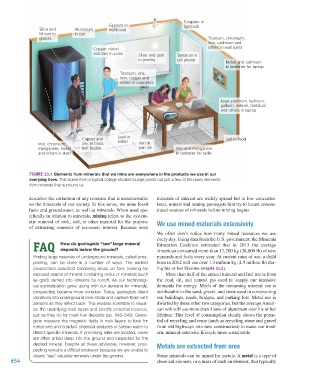Page 655 - Environment: The Science Behind the Stories
P. 655
Tungsten in
Gypsum in lightbulb
Silica and Aluminum wallboard
lithium in in can
glasses Titanium, chromium,
iron, cadmium and
Copper, nickel others in wall paint
and zinc in coins Silver and gold Tantalum in
in jewelry cell phone
Nickel and cadmium
in batteries for laptop
Titanium, zinc,
iron, copper and
others in cosmetics
Lead, platinum, hafnium,
gallium, indium, tantalum
and others in laptop
Copper and Lead in Salt in food
Iron, chromium, zinc in brass solder Iron in
manganese, nickel belt buckle pen ink Zinc and manganese
and others in steel in batteries for radio
Figure 23.1 Elements from minerals that we mine are everywhere in the products we use in our
everyday lives. This scene from a typical college student lounge points out just a few of the many elements
from minerals that surround us.
describes the extraction of any resource that is nonrenewable minerals of interest are widely spread but in low concentra-
on the timescale of our society. In this sense, we mine fossil tions, miners and mining geologists first try to locate concen-
fuels and groundwater, as well as minerals. When used spe- trated sources of minerals before mining begins.
cifically in relation to minerals, mining refers to the system-
atic removal of rock, soil, or other material for the purpose We use mined materials extensively
of extracting minerals of economic interest. Because most
We often don’t notice how many mined resources we use
every day. Using data from the U.S. government, the Minerals
FaQ How do geologists “see” large mineral Education Coalition estimated that in 2013 the average
deposits below the ground?
American consumed more than 17,200 kg (38,000 lb) of new
Finding large reserves of underground minerals, called pros- minerals and fuels every year. At current rates of use, a child
pecting, can be done in a number of ways. The earliest born in 2012 will use over 1.3 million kg (2.9 million lb) dur-
prospectors searched promising areas on foot, looking for ing his or her lifetime (Figure 23.2).
exposed seams of mineral-containing rocks or minerals (such More than half of the annual mineral and fuel use is from
as gold) carried into streams by runoff. As our technologi- the coal, oil, and natural gas used to supply our intensive
cal sophistication grew, along with our demand for minerals, demands for energy. Much of the remaining mineral use is
prospecting became more complex. Today, geologists direct attributable to the sand, gravel, and stone used in constructing
vibrations into underground rock strata and capture them with our buildings, roads, bridges, and parking lots. Metal use is
sensors as they reflect back. This enables scientists to visual- dwarfed by these other two categories, but the average Ameri-
ize the underlying rock layers and identify potential reserves, can will still use more than 3 tons of aluminum over his or her
just as they do for fossil fuel deposits (pp. 548–549). Geolo- lifetime. This level of consumption clearly shows the poten-
gists measure the magnetic fields in rock layers to look for tial of recycling and reuse (such as recycling stone and gravel
metal ores and conduct chemical analyses of stream water to from old highways into new construction) to make our mod-
detect specific minerals. If promising sites are located, cores ern, mineral-intensive lifestyle more sustainable.
are often drilled deep into the ground and inspected for the
desired mineral. Despite all these advances, however, pros- Metals are extracted from ores
pecting remains a difficult endeavor because we are unable to
clearly “see” valuable minerals under the ground. Some minerals can be mined for metals. A metal is a type of
654 chemical element, or a mass of such an element, that typically
M23_WITH7428_05_SE_C23.indd 654 13/12/14 11:29 AM

